
 |
[vimeo https://vimeo.com/74280956] |
He’s the popular saint known to help people find lost items and his miracles have won him affectionate veneration among Christians and non-Christians alike.
This autumn, tens of thousands of his devotees in Ireland and Britain are expected to turn out to welcome his relics as they tour the two countries in October and early November.
The relic tour is taking place to mark the 750th anniversary of the discovery of St Anthony’s incorrupt tongue by St Bonaventure.
Padua-based Greyfriar, Fr Mario Conte, OFM Conv, who is Editor of the Messenger of Saint Anthony, will accompany the two relics – a small piece of petrified flesh and layers of cheek skin.
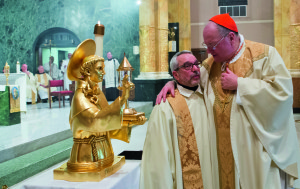 The magazine, which was founded in 1898, seeks to spread devotion to Saint Anthony and to promote works of charity in favour of the poor.
The magazine, which was founded in 1898, seeks to spread devotion to Saint Anthony and to promote works of charity in favour of the poor.
It has over 10,000 subscribers in Ireland alone and a similar number in the UK and is circulated in the USA, Canada, Australia, and elsewhere in the English-speaking world.
St Anthony died in 1231 and was originally buried at Sancta Maria Mater Domini Church in Padua. His remains were later moved, in 1263, to the current Basilica in the Italian city.
When St Bonaventure, who was head of the Franciscan Order at the time, presided over the opening of Anthony’s coffin, he discovered that though the rest of his body had decayed, the Saint’s vocal organs were intact, including a red and soft tongue.
“Oh blessed tongue, that ever praised the Lord and led others to praise Him!” St Bonaventure exclaimed. He knew it was no coincidence as the Saint had been known as a wonderful preacher of the Gospel.
According to Fr Mario Conte, “There is nothing superstitious about relics. The real meaning of a relic is love – they are a link of love between the person who venerates and the saint.”
The 2013 tour will see the relics visit Dublin, Wexford, Cork, Limerick, Galway and Belfast in Ireland [Please click here for more information on the itinerary] before the relics cross to Scotland where they will visit Glasgow and Aberdeen. They then continue to Newcastle, Manchester, Liverpool, Chester and London. [Please click here for more information on the itinerary in UK]
Fr James McCurry OFM Conv, Minister Provincial of the Greyfriars in Britain and Ireland, speaks to CatholicIreland.net about Saint Anthony and the Franciscan calling.
“St Anthony was a friar and a man who could never be content with mediocrity.” Fr James McCurry’s eyes come alive as he shares his intimate knowledge of the life of this much loved saint whose relics will soon arrive in Ireland (17th October) and will then travel on to Britain (26th October).
Although St Anthony is synonymous with the Italian city of Padua, he was in fact Portuguese; born Fernando Martins de Bulhões into a wealthy family in the capital, Lisbon on 15 August 1195. He is known the world over as the saint who helps people find lost things and lost people. During his lifetime he gained a reputation for being a strong preacher with an expert knowledge of scripture.
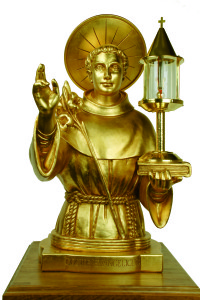 After his death at the Poor Clare monastery in Arcella on 13 June 1231, when he was just 35, he was canonised by Pope Gregory IX on 30 May 1232, less than a year after his death.
After his death at the Poor Clare monastery in Arcella on 13 June 1231, when he was just 35, he was canonised by Pope Gregory IX on 30 May 1232, less than a year after his death.
“If you study the life of Anthony, he was never content with the status quo. He felt that the Gospel impelled him to continual conversion of life and heart. This may partly explain why his life was so eventful. It included setting off to become a martyred missionary in Morocco and when that quest failed, getting shipwrecked off the coast of Italy, the country he was to make his home, though he also combated some of the heresies of his day in southern France,” Fr James explains.
As a Franciscan friar, following in the footsteps of St Francis and St Anthony, Fr James understands his own vocation as “a calling to a continual conversion of heart. I see Anthony as a touchstone for my own call to continual metanoia – a continual renewal and conversion of heart – never to be content with mediocrity – never to let the gospel message be simply words. It has to be deeds of supernatural charity, concern and a commitment to proclaim the truth even when the truth is a difficult pill to swallow.”
St Anthony, Fr James comments, was a man who called a spade a spade – not an agricultural implement! “His writings were very clear and he didn’t suffer fools gladly. He was sweet and pious but he was also simple and direct. I think that is how we have to be – the truth is the truth! Anthony didn’t mince his words as he proclaimed the truth.”
The relics are touring Britain and Ireland to mark the 750th anniversary of St Bonaventure’s opening of St Anthony’s tomb and the discovery of St Anthony’s incorrupt tongue. The feast of St Anthony falls on the 13 June as that is the day on which the Saint died, which was a Friday in 1231. Because he died in Arcella, it took a couple of days for the body to travel back to Padua for burial.
On the Tuesday after his death he was buried. According to Fr James, on that day “there was literally an explosion of miracles in Padua – blind people, cripples and the deaf were healed. People marvelled at the healing aspect that his mortal remains bore. So from that day onwards, beginning in Padua, Tuesdays were associated with the healing power of St Anthony, and to this day the St Anthony novenas take place every Tuesday.”
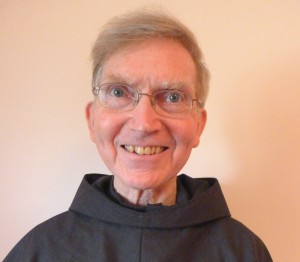 Speaking of the visit of the relics to Ireland and Britain, Fr James explains that he sees it as an opportunity for him as Minister Provincial of the Conventual Franciscan Friars in the eastern US, Britain and Ireland to promote the message of truth and gospel charity as well as of the healing that St Anthony conveys.
Speaking of the visit of the relics to Ireland and Britain, Fr James explains that he sees it as an opportunity for him as Minister Provincial of the Conventual Franciscan Friars in the eastern US, Britain and Ireland to promote the message of truth and gospel charity as well as of the healing that St Anthony conveys.
He will attend the official arrival of the relics in Fairview Church in Dublin on 17 October, along with the papal nuncio, Archbishop Charles Brown, and Archbishop Diarmuid Martin of Dublin. “I want to give a strong stamp of approval to all of my fellow friars as they continue to proclaim that Anthonian message,” he explains.
“We have a long and graced history in these isles,” Fr James continues. Franciscan Friars arrived in Ireland during the lifetime of St Francis. They are known as the Greyfriars because of the colour of the habit they wore. “At that time we were all one family and the habit was made from an unbleached wool and looked greyish – that is why the people called us the Greyfriars. We landed in Canterbury in 1224 – the very month that St Francis was on Mount Verna receiving the stigmata. A few years after that we came to Ireland, certainly by 1230.”
He realises that sometimes people get confused between the different branches of the Franciscan family – Conventuals, Oberservants and Capuchins.
“There is one Franciscan charism and we are one large Franciscan family. We all trace our spir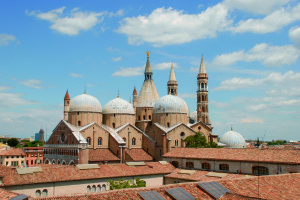 itual ancestry back to the late Francis of Assisi who died in 1226. He founded an order of friars to be men committed to the poor and to evangelisation.
itual ancestry back to the late Francis of Assisi who died in 1226. He founded an order of friars to be men committed to the poor and to evangelisation.
He then founded an order of cloistered Sisters to be women of great prayer and to support the work of the Franciscan family. These came to be known as the Poor Clares because their foundress along with Francis was Clare of Assisi.”
Those who followed the rule of the First Order are the Conventuals, the Observants and the Capuchins. The Conventuals are the smallest branch of the first order. The Observants are much larger and the Capuchins are also larger.
“In these isles the Conventuals wear the grey habit, the Observants wear the brown habit and the Capuchins wear the chestnut-coloured habit. We are three branches and we love each other and support each other in our mutual living of the charism of Francis of Assisi,” Fr James comments.
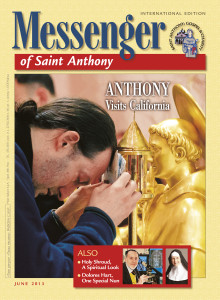 At the beginning of September, Friar Rory Doyle from Wexford took his Solemn Vows – his final perpetual commitment as a friar in his native county. He is the first Conventual Franciscan to profess vows in Wexford Town in over 527 years.
At the beginning of September, Friar Rory Doyle from Wexford took his Solemn Vows – his final perpetual commitment as a friar in his native county. He is the first Conventual Franciscan to profess vows in Wexford Town in over 527 years.
He is also the first of this new batch of friars who have joined the Conventuals in Britain and Ireland in recent years.
“Vocations are a grace from God, one cannot always give a reason for the way that God moves. It does seem that over the past five or six years our Conventual Franciscan Friars have experienced an upsurge of vocations in Britain and Ireland and we now have 12 men in formation. We’re treating them with great care and concern that they are given proper formation to be the type of Franciscan friars that God is calling them to be.”
A number of high profile bishops in Ireland and Britain have already indicated that they will participate in ceremonies associated with the relics.